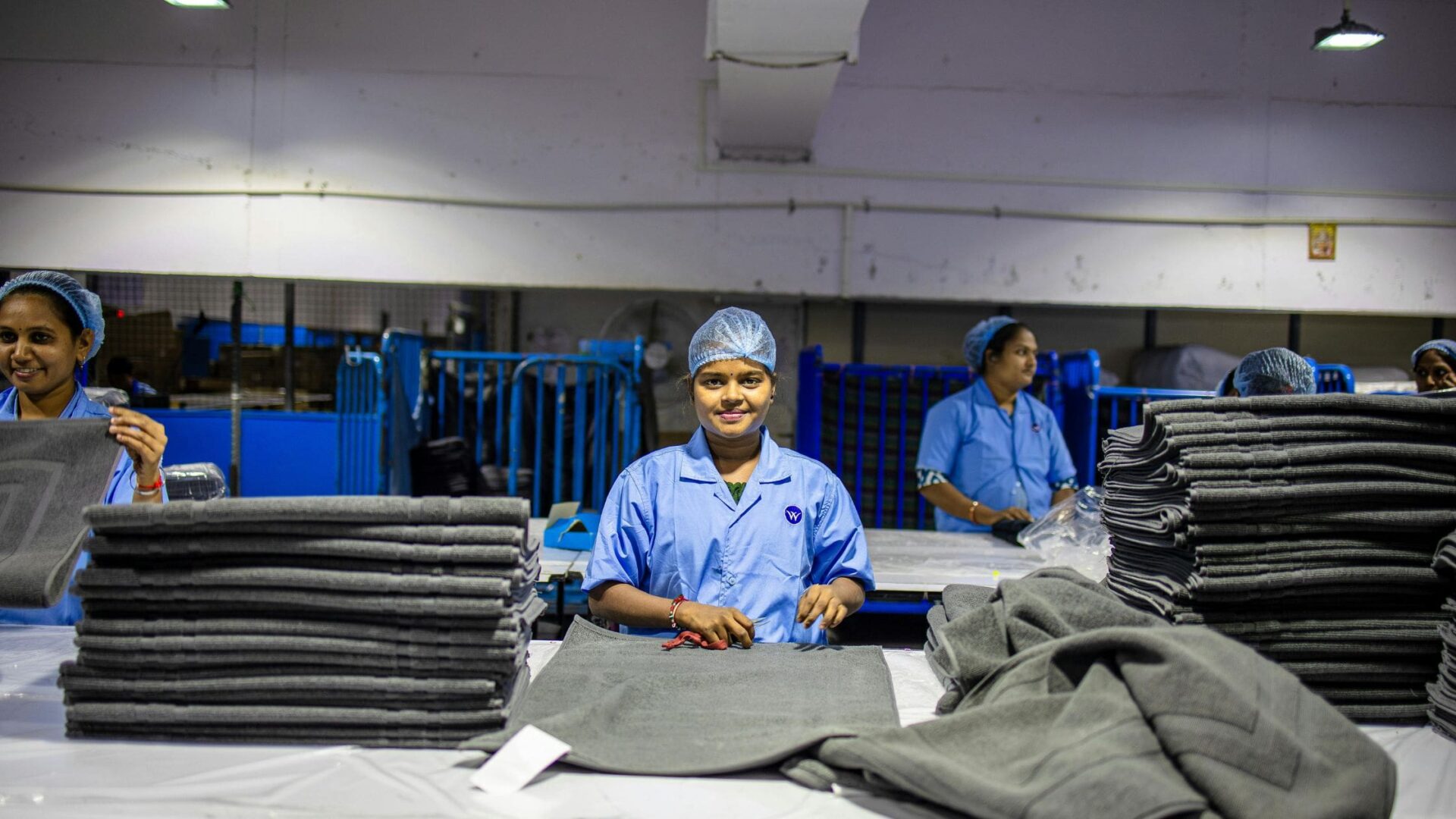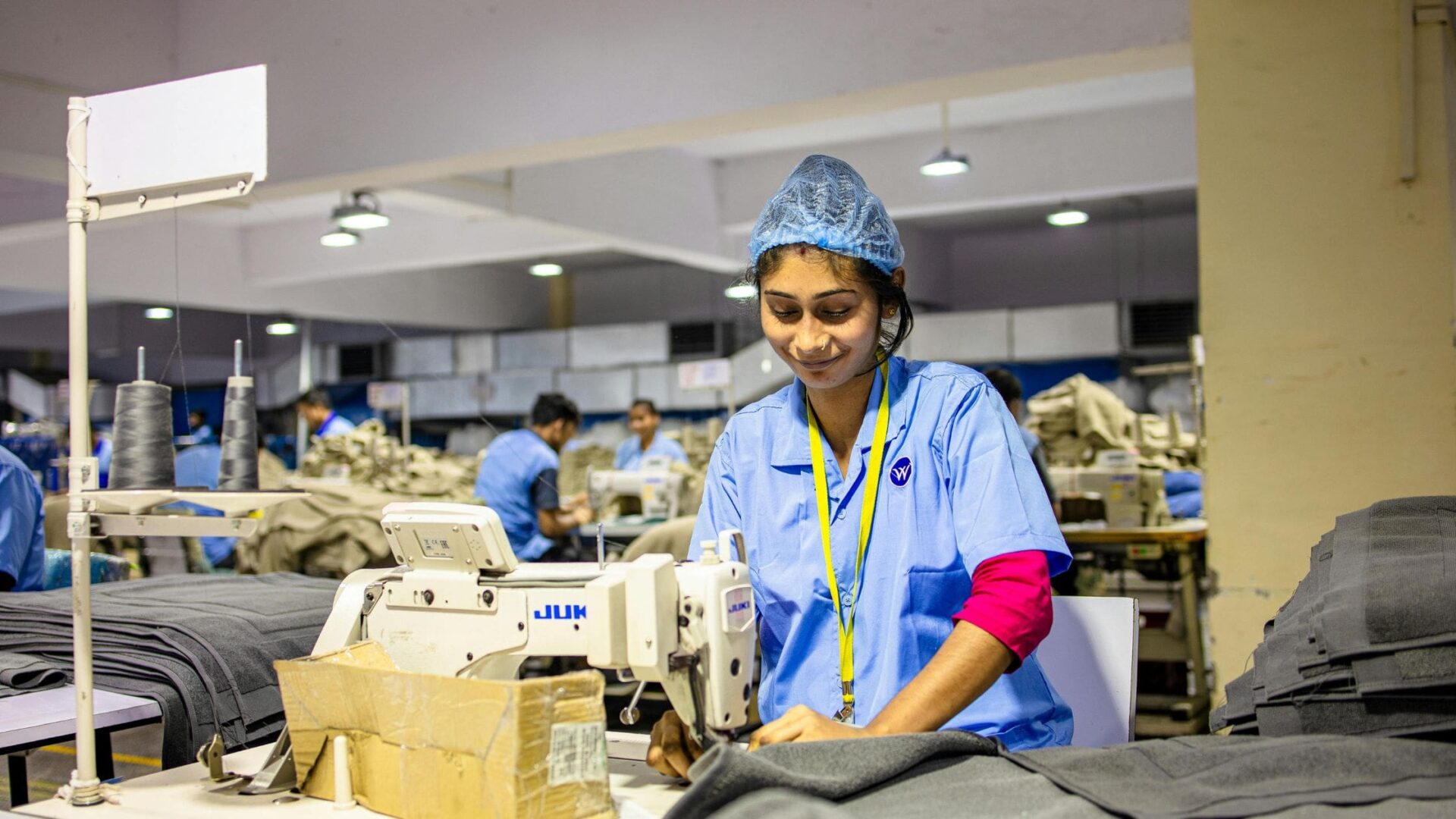Bringing a product to life starts with more than just a great idea, it starts with finding the right people to build it with you. Choosing a manufacturer is a decision that can make or break your product’s future. You’re not just picking a factory, you’re building a relationship with someone who gets your business model, your product design, and your goals.
And timing matters. In 2022, over 300,000 manufacturing jobs were reshored to the U.S., a clear sign that the industry is changing. At the same time, 83% of consumers now expect brands to take the lead on sustainability and ethics. That means who you work with, and how they work, matters more than ever.
Add in rising shipping costs and middlemen who add 30% or more to the price, and you start to see why cutting them out can reduce your production costs by up to 65%. But this isn’t just about money. You’ve got to think about quality control, intellectual property, and long-term supply chain planning.
In this article, we’ll focus on how you can find the right manufacturer for your product, and turn your idea into something real, without losing control.
What is a Manufacturer?
A manufacturer is a company that transforms raw materials into finished or semi-finished goods through a structured and repeatable production process. Unlike wholesalers or trading companies, manufacturers own the machinery, facilities, and labor needed to produce goods at scale. If you’re trying to find a manufacturer for your product, you’re looking for a business that specializes in converting your product design into a physical reality, efficiently and consistently.
Manufacturers often focus on a specific material type or product category. For example, one factory may produce molded plastics while another handles metal subassemblies. This specialization helps improve product quality, lower production costs, and streamline communication. Many entrepreneurs work with multiple manufacturing partners across different categories to lower risk and increase supply-chain resilience.
Unlike artisans or job shops that produce one-off creations by hand, manufacturers rely on mechanized tools and automation. You can often distinguish a factory from a middleman by its catalog, true producers rarely list unrelated items like furniture and electronics under one label.
What Does a Manufacturer Do?
A manufacturer performs a range of technical and operational tasks to bring your product concept to life. This includes sourcing raw materials, setting up specialized equipment, scheduling skilled labor, and ensuring that each production step follows strict quality control protocols. The entire manufacturing process is designed to deliver consistent output that meets predefined specifications, even at higher order quantities.
Many manufacturers also offer optional value-add services. These may include in-house prototyping, CAD support, custom tooling, packaging, and private-label branding. If your business needs help with product development or compliance, some manufacturers can assist with certifications or logistics coordination as well.
One important factor to assess is vertical integration. The more steps, like injection molding, surface finishing, and assembly, a company handles in-house, the more control it maintains over production time and cost. Reputable factories will show their past experience with similar products and should be able to provide a written process flowchart for review.
Is a Manufacturer the Same as a Supplier?
A manufacturer and a supplier are not always the same thing. All manufacturers are suppliers, but not all suppliers are manufacturers. For instance, a manufacturer produces goods in-house, while suppliers may include distributors, wholesalers, dropshippers, or trading companies that simply resell goods made by someone else.
Take the example of a car engine plant. That company might manufacture engines for its own brand but also supply parts to other vehicle companies. In this case, it’s both a manufacturer and a supplier. However, if you’re working with a supplier that doesn’t operate a factory or own any production equipment, you’re likely dealing with a reseller or intermediary.
This distinction matters because middlemen can raise your per-unit price significantly, often by 30% or more. They may also obscure visibility into the actual factory’s practices, from quality control to intellectual property protections. When reviewing quotes or checking a company’s business license, always verify whether you’re speaking directly with a factory or through a third-party trading company.
How to Find a Manufacturer?
Finding a manufacturer can be complex, but following a structured approach makes it manageable. You’ll need to evaluate manufacturing partners based on your production goals, intellectual property needs, and cost limits, while also confirming they’re not just trading companies or wholesalers posing as factories.
This section will walk you through a seven-step roadmap to help you search, assess, and select the right manufacturer for your product. You’ll start by learning how to search across platforms like Alibaba, supplier directories, and trade shows. Then, you’ll explore how to use referrals, evaluate domestic versus overseas manufacturing, prepare the right documents, compare quotes, and vet your shortlists. These steps don’t just help you source goods, they improve your control over production costs, protect your brand name, and ultimately influence profitability and product quality.
Where and How Can You Search for a Manufacturer?
Search engines like Google remain a solid starting point, use queries like “OEM,” “custom factory,” or “contract manufacturers” combined with your product category. Add advanced search operators to uncover low-ranking but legitimate factory websites that aren’t SEO-optimized.
Global marketplaces like Alibaba, AliExpress, and IndiaMART offer access to thousands of producers, but you must filter results. Prioritize factories with Gold Supplier or Verified badges and at least five years of activity. Watch for trading companies masquerading as factories by requesting factory videos or a dated photo of your name inside their workshop.
Offline, you can meet qualified manufacturers at trade shows. Bring technical specs, samples, and packaging expectations. Look for booths displaying certifications like ISO 9001. For U.S.-based options, check supplier directories such as Thomasnet, IndustryNet, Kompass, and the Council of Manufacturing Associations. NAICS codes are also useful, they help you identify factories that specialize in your material or production type.
Can You Use Referrals and Professional Networks?
In many cases, the fastest way to find a trustworthy manufacturing partner is through referrals. If you know other business owners or product developers, ask who they’ve worked with. Founders’ Slack groups, alumni circles, LinkedIn communities, and even Shopify or industry-specific Facebook groups are rich sources of qualified contacts. Many entrepreneurs are open to sharing their experience, especially if they’ve had both wins and failures.
When reaching out, keep your message short and clear. Introduce your business, your product category, your expected order quantity, and timeline. Mention any non-negotiable requirements like ISO certification or ethical labor standards. Even if someone declines to refer you directly, they may still provide a useful tip, such as which region to search in or which factories to avoid. This kind of informal feedback is often more valuable than customer reviews or supplier databases.
Should You Choose a Domestic or Overseas Manufacturer?
When deciding whether to work with a domestic or overseas manufacturer, you need to weigh trade-offs in cost, quality, speed, and risk. Right now, most manufacturing activity occurs outside the United States. According to McKinsey, only about 8% of U.S. employment is in domestic manufacturing. Countries like China, India, and Vietnam lead the field in offering lower production costs, especially for high-volume, labor-intensive items. But lower cost doesn’t always mean better value.
Domestic factories provide advantages in communication, shorter lead times, and easier factory audits. They often follow tighter quality control procedures and stricter labor laws. This can protect your intellectual property and simplify compliance with U.S. regulations. On the other hand, overseas manufacturing offers wider access to niche product categories and established supply chains for many types of goods.
With reshoring on the rise, many business owners are rethinking their sourcing strategy. Still, global events and inflation affect consumer decisions—64% say they’re more flexible on “Made in USA” labels due to higher prices, but 83% still want ethical sourcing. Overseas suppliers often need you to manage time-zone challenges, language gaps, and longer shipping timelines.
What Factors Should You Consider When Choosing a Location?
Where your manufacturer is located affects more than just shipping costs, it shapes every part of the manufacturing process. Always balance cost versus convenience. Overseas production typically lowers unit price but adds complexity in freight, customs, and inspection. Domestic options reduce delays and simplify site visits but often carry higher labor costs.
You also need to consider product quality. Local factories often meet U.S. certifications like ISO 9001 and are easier to audit. Overseas partners may still offer excellent quality, but verifying their track record takes more effort, including background checks, sample reviews, and third-party audits.
Monitoring access matters, especially for custom or high-margin goods. Local access means you can respond faster to issues. When working overseas, you may need sourcing agents or inspectors on-site.
Cultural and time zone differences can affect communication. Make sure the factory has bilingual staff available through platforms like WhatsApp or WeChat. Finally, regulatory risks matter. Check for compliance with laws such as the Uyghur Forced Labor Prevention Act and ask about local energy costs, labor laws, and infrastructure stability.
What Should You Prepare Before Looking for a Manufacturer?
Preparation improves your chances of attracting a manufacturing partner that aligns with your goals, capabilities, and product concept. This process starts with creating a realistic budget, setting a timeline, and estimating your initial order quantity. Even a basic forecast helps you avoid misunderstandings later in the negotiation.
Next, draft a non-technical “elevator brief” that outlines your product idea, brand name, intended audience, and business model. This helps potential manufacturers understand the overall purpose behind your product categories. Pair this with a detailed spec sheet you can share under a non-disclosure agreement (NDA), especially if your product involves intellectual property.
In addition to text, visual aids are essential. You can sketch by hand, build simple 3D models, or record a short video showing function and form. If your design uses any standard or off-the-shelf parts, include that, doing so can reduce tooling time and lower production costs.
What Product Information Do You Need to Finalize?
To begin serious conversations with potential manufacturers, you need to finalize key product information in advance. That starts with design files, such as sketches, CAD drawings, or reference samples, and continues with exact specifications for materials, dimensions, and surface finishes. These technical details shape the entire manufacturing process, from prototyping through full-scale production.
Your documentation should include raw materials requirements and any innovative features that make your product different. This helps the factory anticipate production challenges and ensure product quality from the beginning. If your idea involves sensitive tolerances or assembly requirements, include those upfront to prevent delays and rework.
Budget also plays a role. Define the scope of work and pricing targets, including your profit margins and minimum order quantity. List any certifications the product must meet (e.g., RoHS, CE, ASTM) and identify intellectual property protections already in place, such as patents or trademarks. Confirm that the materials you specify are available in your preferred country or region.
How Can You Vet and Select the Right Manufacturer?
To confirm their legitimacy, request a copy of their business license and cross-check it with local government databases. Use directories like Dun & Bradstreet or the Better Business Bureau to look for complaints or legal disputes tied to the company name.
Next, assess their manufacturing process. Ask what product categories they specialize in and whether they handle everything in-house—such as tooling, finishing, and final packaging. Manufacturers that manage these steps internally often provide more consistent lead times and tighter quality control. Look for certifications like ISO 9001 or ISO 13485, and ask for documented quality procedures.
You should also evaluate data privacy and IP protections. A professional manufacturer should be transparent about their information security policies. If you’re unsure whether you’re dealing with a real factory or a trading company, ask for a photo showing your project name and the current date inside the facility. Compare third-party audit reports (like Sedex SMETA or SA8000) to understand working conditions and sustainability compliance.
What Questions Should You Ask Potential Partners?
Before choosing a manufacturing partner, it’s important to ask the right questions. These help clarify capabilities, expectations, and contract terms. Here’s a checklist of what to cover and why each question matters:
- Do you manufacture custom orders?
Confirms if they can support your product idea, especially if it involves complex assembly or innovation. - What are your minimum order quantity (MOQ) requirements?
Helps you understand whether your target order quantity fits their business model. - What is your average turnaround time (in days)?
Allows you to align your production timeline and delivery expectations. - What are your sample fees and refund policy?
Indicates how risk is handled in early prototyping or sample evaluation. - What payment terms do you offer?
Common terms are 30% upfront and 70% before shipment—some offer flexible milestone-based options. - What’s your defect rate and how do you handle returns?
Offers insight into product quality and post-sale accountability. - Do you hold any ethical or labor certifications like SA8000?
Ensures alignment with your sustainability and labor values. - What is your exclusivity policy on custom tooling?
Clarifies who owns the tooling and whether it’s reused across other products. - Can you share your standard shipping terms and freight class?
Affects logistics planning and shipping costs.
How Do You Research a Manufacturer’s Reputation?
Before you commit to a manufacturing partner, take time to evaluate their legitimacy and track record. Your first stop should be to review their Better Business Bureau (BBB) ratings, court records, and trade-credit reports. These tools can reveal financial issues or unresolved disputes. On platforms like Alibaba, look for factory audit videos, on-site verification photos, and third-party inspection badges to validate overseas manufacturing claims.
Always verify business license numbers through regional or national directories. Cross-check ISO certifications on issuer websites to confirm that quality management standards are current. If available, request client references and follow up, ask about communication, fulfillment timelines, and product quality consistency.
You should also check regulator databases for past labor violations or fines. Consistent issues may signal long-term problems with working conditions or compliance. Finally, engage with industry-specific forums, Facebook mastermind groups, or LinkedIn networks to collect peer reviews. These firsthand insights often reveal concerns you won’t find on public platforms.
How Can You Understand a Manufacturer’s Capabilities?
Understanding a manufacturer’s technical scope helps you avoid miscommunication and costly surprises. Begin by asking how much of the manufacturing process is handled in-house. Factories with high vertical integration typically manage production more efficiently, from prototyping to final packaging. Request a process flowchart to identify which steps, like tooling, surface finishing, or assembly, are outsourced to third parties.
You can also ask for a list of machinery and equipment. This might include CNC machining centers, injection-molding machines, or laser cutters. The range and capacity of these tools indicate whether the facility is a good fit for your product design and materials.
Confirm whether they offer services like warehousing, custom packaging, or drop-shipping. These additional features can simplify logistics and help reduce fulfillment costs. Finally, ask whether compliance testing is done in-house or outsourced to third-party labs, this detail impacts both timeline and cost when obtaining certifications for regulated product categories.
How Can You Confirm You’re Working Directly with a Factory?
Always request a high-resolution photo of your project name and the current date placed on production equipment or the factory floor. This step is simple but powerful in verifying legitimacy.
Check the business name and branding. Phrases like “Trading Co.” or websites listing wide product categories, like electronics, furniture, and clothing, often signal that the company is a distributor, not a factory. Authentic factories usually specialize in a narrow range of product categories tied to specific materials or manufacturing processes.
Use government databases to cross-reference their business license registration and physical address. Any mismatch is a red flag. When possible, schedule a live video tour or visit the facility yourself. Seeing the actual equipment, labor setup, and workflow can confirm scale and credibility.
How Can a Third-Party Factory Auditor Help When Evaluating Manufacturing Quality?
Yes, when you’re trying to find a manufacturer you can trust, third-party audits are one of the most powerful tools available. A factory audit is a structured, on-site evaluation of a manufacturer’s facility. It can focus on different categories, such as social responsibility, environmental impact, or product quality. Third-party audits give you a neutral view of the company’s performance across these fields without relying on marketing claims or polished presentations.
You gain access to data that’s verified by an external expert, which reduces your chances of falling victim to fraud. It also accelerates the due diligence process, helping you confirm whether a manufacturing partner meets your standards before signing a contract. These audits are especially helpful for business owners exploring overseas manufacturing options or unfamiliar product categories.
Also, audit timing matters. Ideally, schedule one before signing a production agreement, then repeat it annually to verify consistency. Many third-party providers operate across Asia, especially in China, Vietnam, and India, and can deliver detailed results within a week.
Typical deliverables from a reputable audit firm include:
- Corrective and Preventive Action (CAPA) report: A breakdown of issues, fixes, and timelines.
- Photo documentation: High-resolution images of the factory floor, equipment, and workstations.
- ISO-gap matrix: A side-by-side comparison of current practices against ISO 9001, ISO 14001, or SA8000 standards.
How Do You Request and Compare Quotes?
Send a clear request for quotation (RFQ) to at least three potential manufacturers. Include detailed specifications, such as dimensions, materials, product design files, surface finishes, and expected order quantity brackets. This ensures consistency across quotes and allows you to compare pricing, turnaround time, and services side-by-side.
Ask for line-item breakdowns. You want per-unit costs across volume tiers, lead times, tooling fees, packaging details, and sample charges. Make sure the manufacturer for your product also itemizes setup or mold fees, even if refundable later. This gives you a realistic view of production costs.
Watch for hidden charges. Things like currency fluctuations, third-party inspections, overseas shipping costs, duties, and rework fees can quickly eat into profit margins. Request clear payment terms, timelines, and service scope in writing to protect your bottom line.
How Do You Assess a Manufacturer’s Quality?
Evaluating a manufacturer’s quality isn’t about trusting a polished presentation, it’s about examining the manufacturing process itself. Begin by reviewing sample units against approved spec sheets. You’re not just checking form and finish, you’re confirming that the final goods match your product concept within acceptable tolerance ranges for your industry.
Next, ask about internal quality control protocols. This includes raw material checks, in-process inspections, and final product verification using Acceptable Quality Limit (AQL) sampling. These steps help identify production defects before full shipments leave the facility.
Request traceability documentation. Lot numbers, batch codes, and product test reports allow you to track any defects back to specific production runs. That’s especially critical for contract manufacturers working across multiple shifts or job shop setups.
For consistent inspection, store a signed, dated “golden sample” at your location, and make sure another is kept on the factory floor.
Why Is It Important to Order and Evaluate Samples?
Samples are your first hands-on look at how a manufacturer interprets your product idea. Without them, you’re operating on assumptions, and in manufacturing, assumptions are expensive. Ordering samples allows you to evaluate the product quality, fit, and finish before scaling up to full production. It’s your first checkpoint in converting a concept into something real.
When evaluating product samples, use a written spec sheet and perform functional testing that reflects real-life usage. This could mean checking thread alignment, running drop tests, measuring part tolerances, or stress-testing for wear. If your product has moving components or requires labeling, make sure these features align with your design and branding standards.
Retain at least two production samples. Label one with a date and signature and store it as a golden control. Use the second for stress testing or prototyping. Most manufacturers will deduct sample fees once cumulative orders exceed a minimum order quantity threshold, so negotiate this early.
How Can You Calculate the Total Manufacturing Costs?
When you find a manufacturer for your product, it’s tempting to focus only on the unit cost. But that’s just one part of a much larger equation. You also need to include expenses like design iterations, 3D modeling, prototyping, compliance testing, and international shipping costs. If you’re working with overseas manufacturing partners, remember to factor in customs, duties, warehousing fees, and freight insurance.
Build a cost sheet that accounts for:
- Tooling, setup, and mold charges (including custom items or plate fees)
- Tariffs and port handling costs, which vary by country
- Third-party lab testing, especially for certification or restricted materials
- Currency exchange risks and hedging fees if you’re paying in RMB or EUR
You should also add a 2–3% contingency buffer for rework or scrap—particularly with new product categories or low-MOQ trial runs.
Then use the profitability formula to sanity check your pricing:
Profit = (Sale Price – Unit Cost) – Customer Acquisition Cost.
How Do You Calculate Gross Margins?
Gross margin tells you whether your business model can survive beyond the prototype stage. You calculate it using the formula:
(Selling Price – Landed Cost) ÷ Selling Price × 100%
Landed cost includes everything it takes to get the product in hand: manufacturing cost, packaging, freight, duties, and storage. It’s not just the factory price. If you’re using contract manufacturers or job shops, always confirm that all additional fees are reflected.
Once you calculate gross margin, run multiple scenarios using different order quantities. You’ll often see significant improvement when you hit volume-based price breaks. The more you optimize your supply chain and batch sizes, the stronger your margins become.
If your customer acquisition cost eats up the entire product margin, there’s no room left for marketing, overhead, or growth. That’s a red flag. Always ensure your margins are healthy enough to support long-term sales, returns, and fulfillment without sacrificing profit or quality.
What Hidden Manufacturing Costs Should You Budget For?
If you’re sourcing overseas, you’ll likely encounter international wire-transfer fees, bank hold times, and unpredictable currency fluctuations. These seemingly small items can erode your profit margins over time.
On the logistics side, customs broker charges, demurrage, and storage costs at port can escalate quickly, especially if documentation is missing or delayed. And when sourcing raw materials, surcharges on metals, polymers, and other inputs may fluctuate due to supply chain pressures or energy levies from the supplier’s country of origin.
You also need to account for yearly renewals of compliance certifications such as FDA or CE marks. These costs aren’t one-time, they recur, and often require additional testing.
If you or your team plan to travel for a factory audit, factor in flights, hotels, interpreters, and business license verification. And don’t overlook warehouse storage fees. During peak seasons, rates spike, so negotiate off-season contracts if you have the volume flexibility.
How Do You Negotiate Terms with a Manufacturer?
Once you shortlist factories or contract manufacturers, negotiating terms becomes the next critical step. You’re not just discussing price, you’re shaping the foundation of a long-term business relationship. Most negotiations center on payment conditions, minimum order quantity, lead times, and who absorbs tooling costs in case of design changes.
Frame the discussion as a partnership. Highlight your product’s brand name potential, expected growth, and reorder forecasts. For first-time orders, suggest a 50/50 split: 50% deposit and 50% upon final inspection, or use escrow to protect both sides.
To support your target price, reference market trends, prior quotes, or even Alibaba index data. That context adds legitimacy. If you’re producing low initial volumes, offer tool amortization or phased-in order commitments. This can help you reduce your upfront cost without pushing the supplier to walk away.
Always document terms in a formal contract, including what happens if their process causes rework or delays. It protects your product concept, timeline, and bottom line.
How Do You Approach MOQs and Payment Terms?
Minimum order quantity (MOQ) is often a roadblock for startups, but it doesn’t have to be. Manufacturers set MOQs to optimize production efficiency and spread tooling costs. If the MOQ feels too high for your current inventory plan, start a conversation—don’t accept it as fixed.
You can offer to pay a slightly higher per-unit price for smaller production runs. Alternatively, propose a phased approach: commit to rolling orders across several months, tied to forecasted sales. This reduces the manufacturer’s risk while aligning with your business model.
Most companies request 30% payment upfront and 70% after production. If you’ve built a strong communication history and have good references or credit, you might negotiate net-30 terms or a letter of credit backed by your bank.
In some cases, factories will accept staged payments tied to production milestones, like completion of prototyping or packaging.
How Do You Build a Long-Term Relationship with a Manufacturer?
Trust is earned through transparency, consistency, and effort on both sides. Weekly updates help your manufacturing partner align with your timelines and avoid last-minute surprises.
Make it easier for your partner to succeed by sharing projected order quantities and product categories well in advance. You can also implement a supplier-performance scorecard—this creates a feedback loop for improving product quality without confrontation. When they hit major delivery milestones or cost-reduction goals, acknowledge it.
To strengthen daily communication, use platforms your factory prefers, like WeChat or Skype. Number your questions clearly to ease translation and avoid confusion. Even if production is stable, hold quarterly review calls to stay ahead of bottlenecks. .
Can You Work with Multiple Manufacturers?
You don’t have to rely on one factory. Working with multiple suppliers reduces risk and gives you more control over lead times, quality control, and regional disruptions. This strategy is especially important if you’re scaling product categories across different markets or working with overseas manufacturing hubs.
Distribute SKUs or production phases across different producers to compare performance. Use the same design files, quality standards, and packaging requirements to benchmark them fairly. For intellectual property protection, make sure NDAs and tooling agreements are in place with each company. Keep your IP secure by limiting what each party sees, especially when you’re dealing with trading companies or job shops.
To maintain access, send small recurring orders to your alternate manufacturing partner. That way, if your main supplier in China, Vietnam, or India hits capacity issues, you’re not left scrambling.
What are the Common Risks in Manufacturing and How Can You Avoid Them?
One of the most overlooked risks is invoice fraud. Some trading companies and job shops have been known to submit falsified documents or bank accounts that don’t match official company records. Always verify wire transfer details and require business license copies with matching account names. Conduct supplier audits or engage third-party verification services before sending any deposit.
Labor unrest or forced-labor violations can halt production entirely. Monitor local news, factory certifications, and platforms that track UFLPA compliance. If your products are tied to overseas manufacturing, geopolitical instability and currency swings can impact both your profit margins and delivery timelines.
To protect your product quality and intellectual property, stage your payments. A 30% deposit with the balance released after inspection is a common model. For sensitive product categories, add escrow or quality control agents who can perform mid-line checks.
A solid contingency plan matters. Keep a buffer of inventory that matches your average shipping time, especially if you’re importing from China or other high-volume ports. Shipping costs can spike during peak seasons or delays caused by port strikes or natural disasters.
Preventive actions help reduce exposure and protect your business model. Use regular factory communication, well-structured agreements, and ongoing compliance monitoring to ensure your product idea survives real-world execution.
What are the Most Common Manufacturing Risks?
The most common risks in manufacturing fall into a few clear categories. Understanding them helps you plan, avoid costly mistakes, and maintain consistent product quality as your business grows.
- Production or Shipping Failures: Delays in component sourcing, raw material shortages, or customs hold-ups can stop your production process cold. Keep safety stock and ensure your contract includes delivery timelines and penalties.
- IP Theft: Sharing your product design too early or with the wrong partner can result in clones showing up under a different label. Always use NDAs, register patents, and limit file access to verified producers.
- Fraud or Non-Compliance: Falsified certifications or double-booked factory capacity can lead to unshipped orders or damaged goods. Validate track records using supplier databases and request manufacturer FAQs before onboarding.
- Labor or Ethical Issues: If you’re working with overseas manufacturing partners, you need visibility into labor practices. UFLPA and other US compliance laws now hold you accountable. Factory audits and third-party reports help you stay ahead.
What are the Alternatives to Traditional Manufacturers?
Contract manufacturers and trading companies are common in this space, but they’re not the only paths. Some entrepreneurs use wholesalers to source existing goods for resale. Others go directly to factories or tap into industry-specific supplier directories or B2B platforms like Alibaba. Each approach has its pros, cons, and best-fit scenarios based on your product concept and sourcing goals.
Before you choose, evaluate your needs around product customization, intellectual property control, shipping logistics, and communication preferences. That’s how you find the manufacturing partner that truly aligns with your long-term plan.
Factories
Factories represent a direct route in the manufacturing process. If you’re looking for the lowest possible price per unit, going straight to a factory can be the most cost-effective option. You skip middlemen and deal directly with the source. This gives you more control over your order quantity, packaging, and product quality specifications, especially if you already have a detailed product design or CAD files in hand.
But this approach has its challenges. Factories are not always geared toward working with small businesses or first-time entrepreneurs. If you lack industry contacts or experience negotiating payment terms and production timelines, communication breakdowns can happen fast. Cultural differences and language barriers add complexity, particularly if the supplier is in China or another country where business norms vary.
That said, many business owners still prefer this route when they want full control over product development, costs, and supply chains.
Wholesalers
Wholesalers don’t make products, they buy from producers and resell in bulk. This route simplifies many of the headaches that come with manufacturing. If you’re not ready to dive into tooling, prototyping, or managing production specs, working with a wholesaler gives you access to ready-made goods with far fewer steps.
One big advantage is location. Many wholesalers operate within the U.S., which eliminates overseas shipping costs, import duties, and customs delays. You’ll also benefit from faster delivery times, easier returns, and a higher level of legal protection if anything goes wrong. You can typically communicate in real time without worrying about time zones or translation issues.
However, you’re also giving up control. Since wholesalers sell existing product categories, your customization options are limited. You can’t develop a product from scratch or adjust components to match your brand name or design vision. And since they take a cut, the price per unit is higher.
Trading Companies
Trading companies occupy a space between wholesalers and producers. Unlike factories, they don’t make products. But unlike traditional wholesalers, they tend to offer lower minimum order quantities and greater variety. If you’re trying to find a manufacturer for your product but don’t yet have the volume to work with a large facility, this route gives you access to product categories that would otherwise be off-limits.
Their biggest strength lies in flexibility. You can source items across different suppliers without needing to manage each relationship or deal with supplier databases and factory certifications. This is especially useful if you’re developing multiple product samples or testing various markets through platforms like Shopify or Amazon.
However, that flexibility comes at a cost. Trading companies are middlemen, which drives up your production costs. And the biggest concern? Accountability. You likely won’t know which manufacturer actually produced your goods. If something arrives broken or out of spec, the trading company may deny responsibility—making quality control and feedback loops harder to manage.
H3: Dropshippers
Dropshipping shifts the way you think about manufacturing. Instead of handling goods yourself, the dropshipper stores inventory, fulfills orders, and ships directly to your customers. You focus on the front end—product listings, digital ads, and content creation—while your fulfillment partner handles the logistics behind the scenes.
This model is popular among small business owners and startups who want to test demand before committing to bulk production or negotiating payment terms with factories overseas. It’s also ideal if you’re selling through a marketplace like Etsy, Amazon, or your own eCommerce site. Some manufacturers and wholesalers even offer dropshipping as a service tier alongside traditional bulk orders.
However, there are downsides. You’ll often have less visibility into packaging quality, shipping times, and returns. Since you don’t control the inventory, you can’t run post-production inspections or verify product quality first-hand. And because your brand is layered on top of someone else’s infrastructure, profit margins are thinner and intellectual property risks may increase.
H3: Print on Demand
Print-on-demand services give you another option—especially if your product idea involves designs, art, or custom labels. In this model, you upload your artwork or brand assets to a platform, and when a customer places an order, the system automatically prints and ships the item. No need to manage a factory, worry about a business license in a foreign country, or handle large inventory volumes.
It’s a great entry point for launching apparel, accessories, posters, and even packaging with your own design elements. Since the process is automated, you can focus on social media marketing, growing your contact list, and improving your content strategy while your partners manage the production.
Still, print-on-demand isn’t ideal for every business model. Your cost per unit will be higher than traditional manufacturing, and you’ll have fewer options for material selection or custom components.
Can You Work with Dropshipping Services?
Yes, if you’re using e-commerce platforms like Shopify, WooCommerce, or BigCommerce. Dropshipping services integrate directly with your store to automate order processing, inventory sync, and shipping. This means that when someone places an order on your site, the system forwards it to the supplier, who fulfills and ships the product directly to the customer, often without you touching the item.
Most platforms also offer built-in supplier scorecards or feedback ratings based on things like shipping time, product quality, and communication. These help you assess potential partners before listing their items. Some even allow product samples or trial orders so you can inspect quality control firsthand.
If you’re just getting started or want to avoid storage, packaging, and fulfillment altogether, dropshipping gives you a low-risk, scalable way to test different product categories. While the profit margins are thinner than buying in bulk, the reduced production costs and lower upfront investment often offset that for early-stage businesses.
Is Print-on-Demand a Good Fit for Your Business?
It could be, if you’re designing custom products like apparel, posters, or accessories. Print-on-demand (POD) companies handle everything from automated printing to fulfillment and shipping, so you don’t need to hold physical inventory. You upload your designs, create product pages, and when customers place orders, production starts on-demand.
The biggest advantage? Speed-to-market. You can launch a brand name or test new ideas quickly, without spending months working with contract manufacturers or waiting on overseas production timelines. If you’re in the early stages of validating a product idea or brand, POD lets you gauge demand in real time.
However, margins are usually lower compared to holding inventory yourself or working directly with a factory. You’re paying for convenience and automation, which means your per-unit price will be higher. But for many startups, the trade-off is worth it, mostly if your goal is speed, flexibility, and minimizing risk during the early steps of the business process.
Should You Consider Wholesalers, Suppliers, or Trading Companies?
Absolutely, depending on your product type, sales channel, and growth plan. Each of these models plays a different role in the supply chain, and knowing which one fits your current needs can save you time, money, and confusion.
- Wholesalers buy in bulk from factories and resell goods at markup. This model works well if you want access to finished products without having to deal with manufacturing directly.
- Suppliers may refer to manufacturers, wholesalers, or distributors depending on the context. You’ll need to clarify their role through a directory listing or contact form.
- Trading companies operate as middlemen. Unlike wholesalers, they often offer a broader range of items in smaller order quantities but typically don’t take responsibility for product defects.
If your goal is to reduce landed costs, working directly with a manufacturer for your product can lower expenses by up to 65% compared to wholesale.
What Should You Consider Before Making Your Final Decision?
Before you commit to a manufacturing partner, pause and run a full readiness check. This stage is not about excitement, it’s about protecting your investment, your product, and your business model. Every detail matters when transitioning from concept to production.
First confirm that tooling is complete and tested for accuracy. Assess whether your current logistics infrastructure can scale with volume. If you’re working with overseas manufacturing, review customs processes and shipping costs.
Make sure you’re legally covered with a valid business license and supplier agreements. Review all payment terms, including deposits and timelines for fulfillment. Then, analyze your cash flow projections, are you confident your gross margins can cover customer-acquisition costs, with at least a 10% buffer for unexpected issues?
What Legal Considerations Should You Keep in Mind?
If you’re serious about turning your product idea into a scalable business, you’ll need protections in place before any files or samples leave your hands. That begins with NDAs, strong contracts, and international IP coverage.
A manufacturing agreement should outline production timelines, quality control standards, and payment terms. You also need IP clauses that cover tooling ownership, brand name use, and confidentiality. Encrypted file sharing and access-restricted workspaces add another layer of protection, especially if you’re working with producers in China or other overseas manufacturing hubs.
For startups and small businesses, it’s smart to register patents in the countries where your product will be made. This includes high-risk zones where enforcement may be weaker. And always separate mutual NDAs, one for design contractors and one for suppliers or factories. That way, if a leak happens, you can pinpoint where the breach occurred and respond effectively.
Do You Need an NDA or Manufacturing Agreement?
Yes, both. An NDA (non-disclosure agreement) protects your product concept, design, and trade secrets from being shared without permission. It creates legal accountability before production begins. A manufacturing agreement, on the other hand, defines how the product will be made, who owns the tooling, and what happens if timelines or specs aren’t met.
Be sure your contracts include:
- Tooling ownership: Clarifies that you own the molds, jigs, or dies, even if they stay at the facility.
- Subcontracting clauses: Prohibit subcontracting unless you give written consent. This ensures control over who actually handles your production.
- Penalties and liabilities: Spell out who pays if there’s a product recall or a shipment fails inspection.
- Dispute resolution terms: Identify where legal disputes will be resolved, especially if your manufacturer is overseas.
What Compliance Certifications and Standards Should You Verify?
Certifications signal that the production process aligns with recognized safety, labor, and quality control standards. Failing to check these puts your business, your product, and even your customers at risk.
Focus on core certifications that match your product categories and target markets. For example, ISO 9001 covers quality management systems, while ISO 14001 supports environmental responsibility. If you’re dealing with food-contact items or cosmetics, ensure FDA compliance. For electronics, look for CE for European markets and FCC or UL for the U.S. UL is especially critical if you plan to sell through retailers in the U.S. or list on major e-commerce platforms.
You should also confirm:
- SA8000 or Sedex audits: These address ethical labor practices across global supply chains
- cETLus: Joint U.S./Canada certification for electrical goods
- Expiry validation: Always cross-check certificate numbers on the issuing body’s website. Expired or forged documents indicate weak quality systems or potential fraud.
How Do You Scale Up Your Manufacturing Operations?
Every entrepreneur looking to move from prototyping to high-volume production must prepare for increased order quantities, more advanced tooling, and tighter quality control systems.
You should revisit your current production costs and evaluate whether semi-automated assembly or dedicated molds would reduce unit costs. These tools can dramatically improve efficiency once you pass your first few production runs. If you’re working with contract manufacturers or overseas manufacturing partners, confirm that they can meet higher minimum order quantities without sacrificing lead time or product quality.
To keep growth smooth, implement phased capacity planning. That means setting performance-based trigger points, like hitting 80% of current output capacity, before expanding to a second facility or dual-sourcing through other factories. Dual-sourcing protects you from delays, pricing shocks, and raw material shortages.
Keep your manufacturing partner looped in at each milestone. Treat them not just as vendors but as long-term partners in your business model. Use supplier directories or platforms like Alibaba to find manufacturers who specialize in scaling, and verify their track record with real customer reviews.
What Tools and Software Can Help Manage the Manufacturing Process?
Enterprise Resource Planning (ERP) platforms are vital. They track inventory, order status, and shipping costs in real time. Pair this with Product Lifecycle Management (PLM) tools that manage your bill of materials, product samples, and design changes from concept to completion. If you’re working with job shops or trading companies, use sourcing platforms with built-in communication tools to simplify contract terms and reduce the need for back-and-forth emails.
You should also consider:
- Cloud-based dashboards: These integrate customs data and shipping updates, offering real-time landed cost calculations
- Collaborative portals: Let factories upload quality control photos, batch timelines, and progress milestones for full visibility
- Supplier databases: Help you verify certification status, order history, and NAICS code categorization of potential producers
Conclusion
Bringing your product to life, from that first spark of an idea to shelves or shipping boxes, isn’t easy. But it’s where the real progress begins. As entrepreneurs, we’re not just building a thing, we’re building a system. And every part of that system matters: who you choose to manufacture your product, how you manage timelines, how clearly you communicate, and how well you understand the moving parts of your supply chain.
Most times, success doesn’t come from doing everything perfectly the first time. It comes from showing up, making smart decisions, and treating your manufacturers like true partners. If you’re willing to stay flexible, learn from each step, and keep improving your process as you grow, your product quality and your brand will speak for themselves.
There’s no magic formula, but if you stay consistent, you’ll get there. And we’ll be right there with you.
Frequently Asked Questions
How Do You Position Yourself as an Attractive Partner to Manufacturers?
To stand out, you need to look reliable from the start. Create a clean website, write clear spec sheets, and show realistic volume goals. These small things signal that you’re serious. Add a short overview of your product idea, brand name, and projected sales to give manufacturers something concrete to evaluate.
Also, share your long-term plan. Show that you understand the supply chains involved and have a business model that supports scaling.
How Do Cultural and Language Differences Affect Manufacturer Relationships?
Language issues can lead to misunderstandings in specs, timelines, and even packaging. Always confirm critical parts of your product design in writing and with clear diagrams. Avoid slang or idioms in your emails to overseas suppliers. Precision matters more than personality.
To reduce risk, use bilingual sourcing agents or project managers who understand both the culture and the industry. Cultural-awareness training can also help you build stronger, more respectful relationships that benefit production timelines and product quality.









